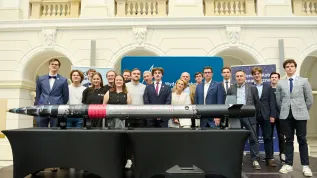
Between 2021-2022, most foreign students in Poland studied management, a new report has found.
Prepared by experts from the National Information Processing Institute - National Research Institute for the Ministry of Education and Science, the report 'FOREIGNERS AT HIGHER EDUCATION INSTITUTIONS IN POLAND’ said: “The most common choice among foreign students in the academic year 2021/2022 was management.
“In 2021, 17 percent of foreign students studied management in Poland. There is also a noticeable increase in interest in this academic major (by 975 people) compared to the previous year.”
In 2020, the internationalisation rate of higher education was 6.8 percent, in 2021 - 7.1 percent.
In absolute terms, between these two years, the number of foreigners increased by 3,340, to the level of 85,900 foreign students in 2021.
Minister of Education and Science Przemysław Czarnek said: “Polish universities have a large scientific capital and are becoming more and more popular among students from other countries. The internationalisation rate of higher education (the share of foreigners among students) has been growing in recent years. In 2019 it was 6.6 percent, in 2020 - 6.8 percent, and in 2021 - 7.1 percent.
“The data contained in the latest National Information Processing Institute report also show that in the academic year 2021/2022, over 38,300 foreign students studied full time at public universities, about 3,200 more than at private universities. When it comes to part-time studies, foreign students more often choose private universities.”
Director of the National Information Processing Institute, Dr. Jaroslaw Protasiewicz, said: “The National Information Processing Institute report 'FOREIGNERS AT HIGHER EDUCATION INSTITUTIONS IN POLAND' shows that since 2012, the share of foreign students choosing private universities has been growing at the highest rate. The consequence of this trend is the changing structure of students at private universities: in 2012, foreign students accounted for only 2.1 percent of all students, in 2015 it was 8.1 percent, and now it is almost 12 percent.
“I must admit that as a computer scientist, I appreciate the fact that IT is very popular among foreigners in our country. It ranks third (after management and medicine) among all majors that foreigners can choose from in Poland.”
According to the report, the analysis of academic majors most often chosen by the group of foreign students reveals the great popularity of medicine. In 2021, it was selected by 9 percent of all foreign students. Computer science was only slightly less popular among foreigners.
The leader of the Data Science team at the Laboratory of Databases and Business Analytics Systems at the National Information Processing Institute, Dr. Aldona Tomczyńska said: “It is also worth noting that the ranking of the most popular academic majors looks different for individual levels of study. First-cycle students most often choose fields from the group of management and administration (mainly full-time students at non-public universities), followed by majors classified as personal and property security, tourism and leisure (almost exclusively foreign students at private universities), followed by economics, political science and social studies.”
Co-author Anna Maziarczyk added: “Among second-cycle students, personal and property security is no longer among the four most popular majors. The popular majors include management and administration, political science and social studies, as well as literature and linguistics. Foreigners at uniform master's studies choose majors in the field of medicine including dentistry.”
The report also indicates that the largest number of foreign students study in large academic cities, such as Warsaw or Kraków. Nearly 26,000 students study at universities located in the Mazowieckie province. The difference between the Mazowieckie province and the second most popular one (Lubelskie) is over 17,000 people.
The report said: “Thirty percent of foreign students study in the following provinces: Lubelskie (8,471), Dolnośląskie (8,011) and Małopolskie (7,908). The following provinces host more than 6,000 foreigners: Wielkopolskie and Łódzkie. Provinces with the smallest number of foreign students, below 1,000 people are: Świętokrzyskie (794), Warmian-Masurian (421) and Lubuskie (240).”
The largest number of foreigners in the academic year 2021/2022 was educated at a non-public university: the Vistula University. 4,900 students born outside our country took up studies there. Among public universities, the Jagiellonian University in Kraków is the leader.
The report does not cover the period after the beginning of Russia's invasion of Ukraine.
In the academic year 2021/2022, 42 percent of all foreign students were Ukrainians, 13 percent were Belarusians. In 2018, there were over 39,000 students from Ukraine in Poland, which accounted for half of all foreigners studying at Polish universities. Since then, both the number and the share of students from Ukraine among foreigners have been gradually decreasing. In 2021, over 36,000 students from Ukraine received education in Poland, accounting for 42 percent of the total number of foreign students.
In the academic year 2021/2022, Polish universities employed 2,458 academic teachers from abroad. Most foreign teachers are employed by public academic universities. Nearly 23.1 percent of all foreign academic teachers were Ukrainians.
Among foreign academic teachers there are also people from Germany (6.1 percent), Italy (5.5 percent), India (4.8 percent), the UK (4.2 percent), Belarus ( 4.1 percent), Spain (3.9 percent) and Russia (3.5 percent).
The report was commissioned by the Minister of Education and Science. It was prepared by a team of experts from the National Information Processing Institute - National Research Institute: Dr. Aldona Tomczyńska, Paulina Urban, Konrad Zwierowicz, Katarzyna Pyrtek, Anna Maziarczyk.
The report is available free of charge on the RAD-on portal. (PAP)
PAP - Science in Poland, Katarzyna Herbut
kh/ mhr/ kap/
tr. RL













